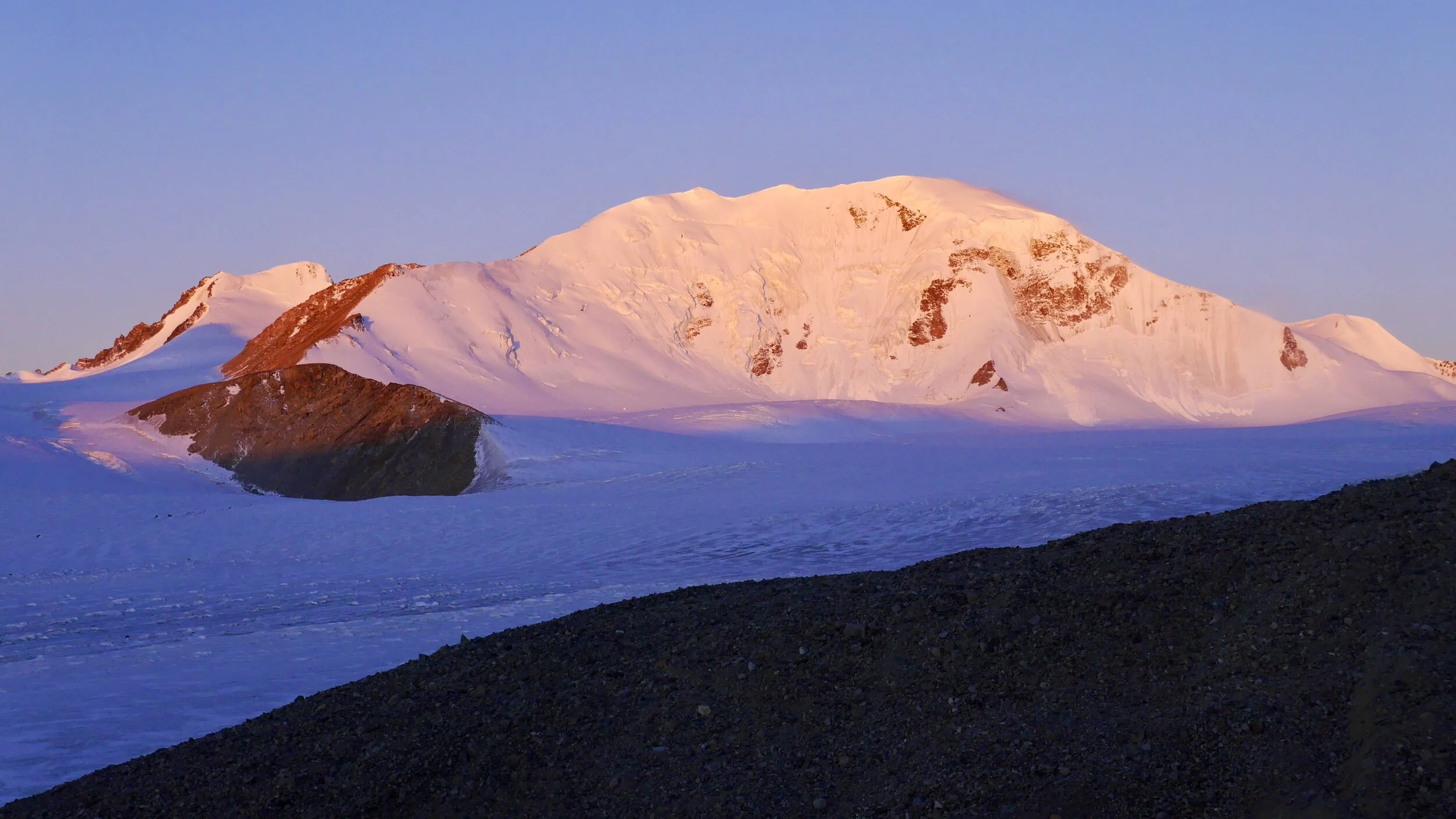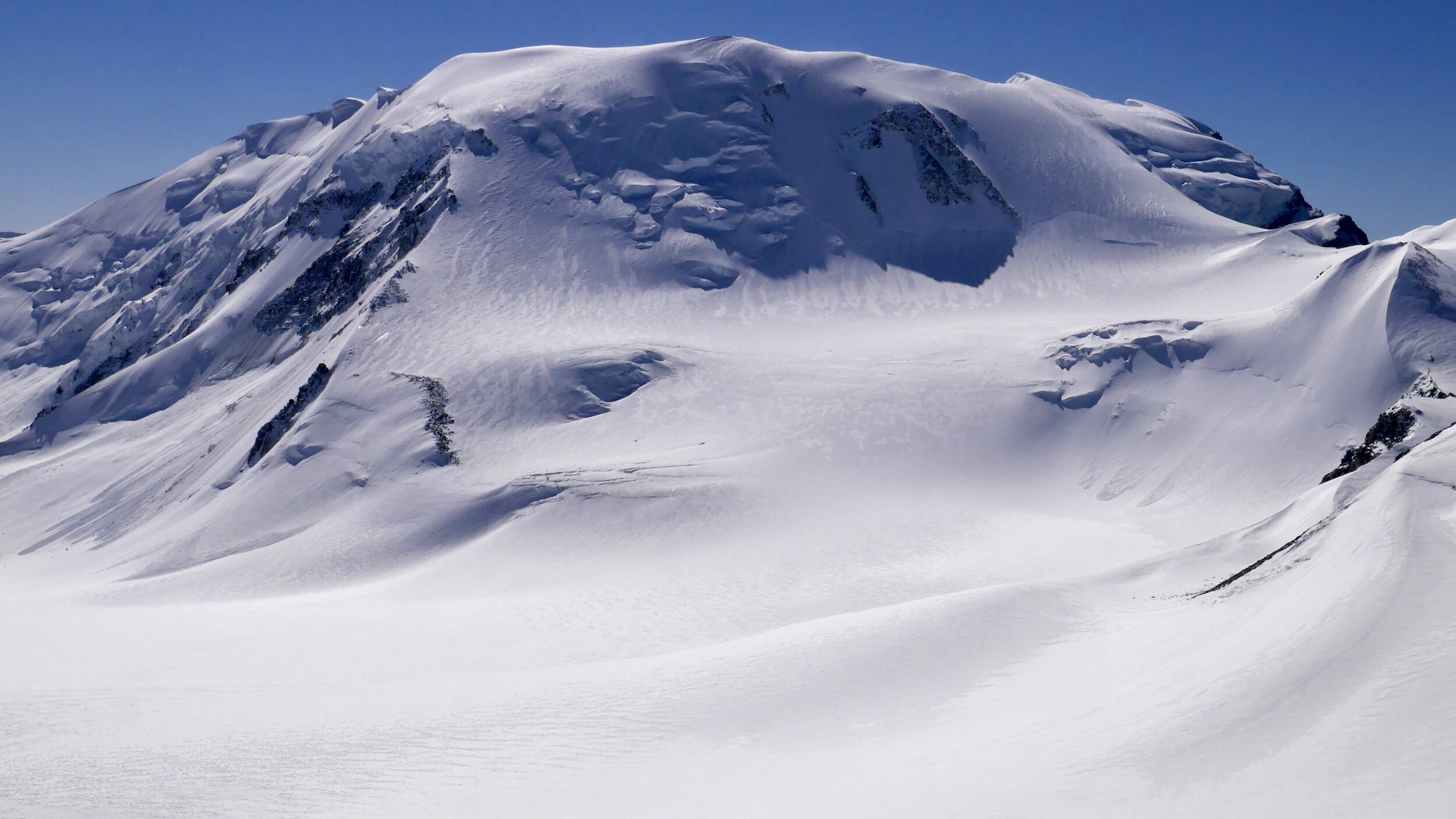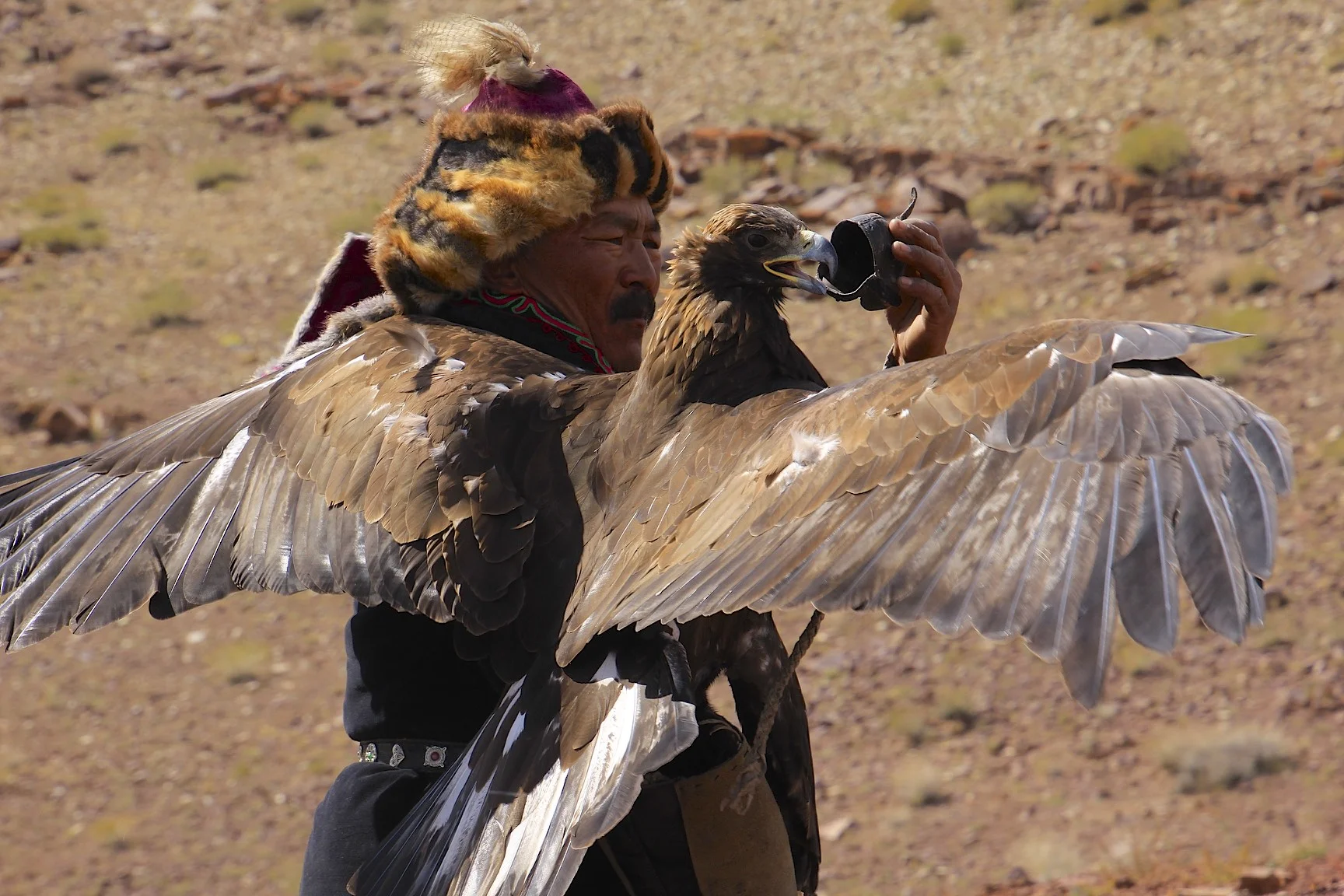Our objective was to climb Mt. Khuiten. Instead we climbed Mount Nairamdal and Mount Malchin.
The confluence of the Potaniin and Alexander Glaciers.
The confluence of the Potanin and Alexander Glaciers
Mt. Khuitan at sunrise
Approaching Mount Khuitan on the Potaniin Glacier.
On the Potaniin Glacier.
Potaniin Glacier
Mout Khuitan from the summit ridge of Mount Nairamdal 4,180m
Looking down to Potamiin Glacier from Mount Nairamdal 4,180m
Mount Malchin 4,050m from Mount Nairamdal 4,180m
Russian Altai - Mount Bielucha from Mount Narimdal
Potiamiin Glacier
Mount Khuitan
Potiamiin Glacier
Mount Malchin 4,050m
Mount Malchin
Summit ridge of Mount Malchin and the Potiamiin Glacier
Potianiin Glacier
Entrance to the National Park of Tavan Bogd in Western Mongolia
After the storm on the Potiamiin Glacier
After the storm on the Potiamiin Glacier
Russia - Mongolia border
Mount Mulchin
Mount Mulchin - the summit at 4,050m
Nick Kirkpatrick wrote in the Washington Post: In parts of China, Kazakhstan, Russia and Mongolia, using eagles to hunt is deeply rooted in a culture in which men worked with birds of prey as early as the 15th century. It’s a rite of passage for Kazakh boys in western Mongolia who learn the craft as early as 13. Passed down through generations, the tradition has a strict set of rules and practices. The hunts happen during winter, when teams of hunters chase their prey by horseback and release an eagle to make their kill. Hunting once provided furs and meat during harsh winters, but the tradition is battling a dwindling number of hunters. [Source: Nick Kirkpatrick, Washington Post, February 10, 2015]
The tradition of eagle hunting is more than a thousand years old. Genghis Khan is believed to have engaged in the sport. Marco Polo described it. In the Mongol era, it is said, a fine eagle and good horse cost the same price and both lent prestige to their owner. The Kazakhs inherited the sport from their Turkic and Mongol ancestors and were practicing it when they emerged as an ethnic group in the 15th century. As one falconer told National Geographic, “When Kazakhs came into the world, they were eagle hunters.”
The Kazakh eagle (golden eagle), according to Reuters, “is one of the world's fiercest, with a wingspan of 6.6 ft, razor-sharp talons and the ability to dive at the speed of an express train -- up to 190 mph.” Hunters prefer females because they are larger and regarded as more aggressive. Females weigh up to seven kilograms, which is a third heavier than males. It takes a great deal of strength to hold one of these large birds in your arm. When horses are on the move the eagles unfurl their wings for balance.
A quality golden eagle is worth $12,000 or more and can hunt for 30 years or more. Many hunters train and keep several birds in their lifetimes, generally releasing them to the wild after 10 years. Golden eagles are skilled hunters. In the nest of one large female, scientists found the remains of 27 foxes, ten gazelles, two eagle owls and one marmot. Golden eagles are struggling in the wild in some places because there is not enough wildlife for then to eat.
Golden eagles can be very dangerous. They occasionally become out of sorts and even dangerous to their owners. Golden eagles have known to vent their anger from a lost kill on a hunter or its horse. People have lost eyes.
Hunting takes place riding a specially trained horse, (called a "bercut”). To allow a rider to carry an eagle a special device (a “baldak”) is fitted onto the saddle to support the rider’s arm. A skilled pair, berkutchi (hunter) and bird, can typically catch 50 or 60 foxes, a dozen badgers, a couple of lynx and 4 or 5 wolves in a normal 4 month season, which starts in the late autumn [Source: advantour.com]
Maria Golovnina of Reuters wrote: “When it snows on the steppes of eastern Kazakhstan, hunters saddle up and gallop off with eagles on their arms in search of prey. The men follow the animal tracks in the snow then release their giant eagles into the air to snatch up foxes and rabbits. "Hunting is my life," said Baurzhan Yeshmetov, a 62-year-old man in an embroidered velvet tunic, his eagle perched on his arm staring menacingly into the foggy hills. When he is not hunting he works as a taxi driver in Kazakhstan's financial center Almaty. [Source: Maria Golovnina, Reuters, December 6, 2009 \^/]
Sent out to hunt fawns, foxes, or other small animals, the eagle dives down on them and kills them. But often it is also capable of killing young wolves when they cannot negotiate the deep snow. Sometimes the eagles hunt in pairs, just as they would in the wild. Eagles rarely fail to catch their prey, which it quickly kills, usually by breaking the neck in its powerful claws. [Source: advantour.com]
Eagles hunters mainly hunt hares, marmots and foxes. The hunter works on horseback. The primary object of the eagle is to catch the prey and grasp it long enough until the hunter shows up and clubs it to death. The eagles are given a piece of meat as a reward after each hunt. They are kept hooded when they are not hunting to keep them calm. During winter hunts, when temperatures can drop to forty below, a hooded eagle is swaddled in leather and carpets to keep warm.
Describing a hunting eagle, Sebastian Allison of Reuters wrote, “High on a hillside overlooking the sweeping central Asian steppe, a horseman gazes down on the snow-dusted plain....At his signal a gigantic golden eagle glides effortlessly from the horseman’s arm towards the plain, circling once or twice as it soars higher...Movement on the steppe. A new urgency in the eagle’s flight. A tilt of wings as its seeks out the things that caught his eyes. The fox is in its sights. The hunt is on....The bird of prey swoops like lightning and with a tearing of its terrifying, razor-sharp talons the fox’s run is over.”
“You don’t really control the eagle,” Asher Svidensky, whose photographs of hunting with eagles were published by BBC. “You can try and make her hunt an animal — and then it’s a matter of nature. What will the eagle do? Will she make it? How will you get her back afterwards?” [Source: Nick Kirkpatrick, Washington Post, February 10, 2015]
Saksai Golden Eagle Festival
“Although eagles can live for thirty years, the hunters keep each one for only about ten years, then release it to live out its last years in the wild. The bird is taken far away, and the hunter sometimes has to hide, or wait for darkness, to keep it from following him home. When Mohan talked to Shuinshi, in 2012, the old man had released his last eagle the year before. “It was as if a member of my family had left,” he said. “I think about what that eagle is doing; if she’s safe, and whether she can find food and make a nest. Have her hunts been successful? Sometimes I dream about these things.”
Hiking in Western Mongolia
Western Mongolia
Western Mongolia
Olgi - the capital of Western Mongolia
Mongoilan long distance bus service
Western Mongolia
Western Mongolia
The site of Karakorum may have been first settled about 750. In 1220 Genghis Khan, the great Mongol conqueror, established his headquarters there and used it as a base for his invasion of China. In 1267 the capital was moved to Khanbaliq (modern Peking) by Kublai Khan, greatest of the successors of Genghis Khan and founder of the Mongol (Yüan) dynasty (1206–1368) in China. In 1235 Genghis Khan’s son and successor, Ögödei, surrounded Karakorum with walls and built a rectangular palace supported by 64 wooden columns standing on granite bases. Many brick buildings, 12 shamanistic shrines, and two mosques were once part of the city, which also was an early centre for sculpture, especially noteworthy for its great stone tortoises.
In 1368, Bilikt Khan, the son of Togon Timur, the last emperor of the Mongol dynasty of China, who had been banished from Peking, returned to Karakorum, which was partly rebuilt. It was then known as Erdeni Dzu (the Mongol name for Buddha), because during the 13th century lamaistic Buddhism had made progress under Kublai Khan. In the Battle of Puir Nor in 1388, Chinese forces under the leadership of the emperor Hung-wu invaded Mongolia and won a decisive victory, capturing 70,000 Mongols and destroying Karakorum. Later it was partially rebuilt but was subsequently abandoned. The Buddhist monastery of Erdeni Dzu (built 1585), which today remains only as a museum, was built on the city site.
In 1889 the precise location of Karakorum was discovered by two Russian Orientalists working in the area, and in 1948–49 the ruins were explored by members of the Academy of Sciences of the U.S.S.R. Among their discoveries were the site of Ögödei’s palace (in the southwestern part of the city) and the remains of a late 12th- or early 13th-century Buddhist shrine.
Karakorum - the capital of the Genghis Khan Empire
The ancient capital of Genghis Khan - Karakorum
The ancient capital of Genghis Khan - Karakorum
The Gobi desert, one of the world's great deserts, covers much of the southern part of Mongolia. Unlike the Sahara there are few sand dunes in the Gobi; rather you'll find large barren expenses of gravel plains and rocky outcrops. The climate here is extreme. Temperatures reach +40° C. in summer, and -40 in winter. Precipitation averages less than 100 mm per year, while some areas only get rain once every two or three years. Strong winds up to 140 km/h make travel dangerous in spring and fall. Great Gobi National Park is one of the largest World Biospheres, with an area larger than Switzerland. It contains the last remaining wild Bactrian (two-humped) camels, wild ass, and a small population of Gobi bears, the only desert-inhabiting bear.
The Gobi sand dunes
The Gobi sand dunes
The Gobi
The Gobi
The Gobi
The Gobi
During a pause in a snow storm in the Altai Mountains
Western Mongolia
The Gobi
The Altai Range
The Gobi
Flaming Cliffs in the Gobi
The Gobi
Ancient markers and grave stones in Western Mongolia









































































































































































